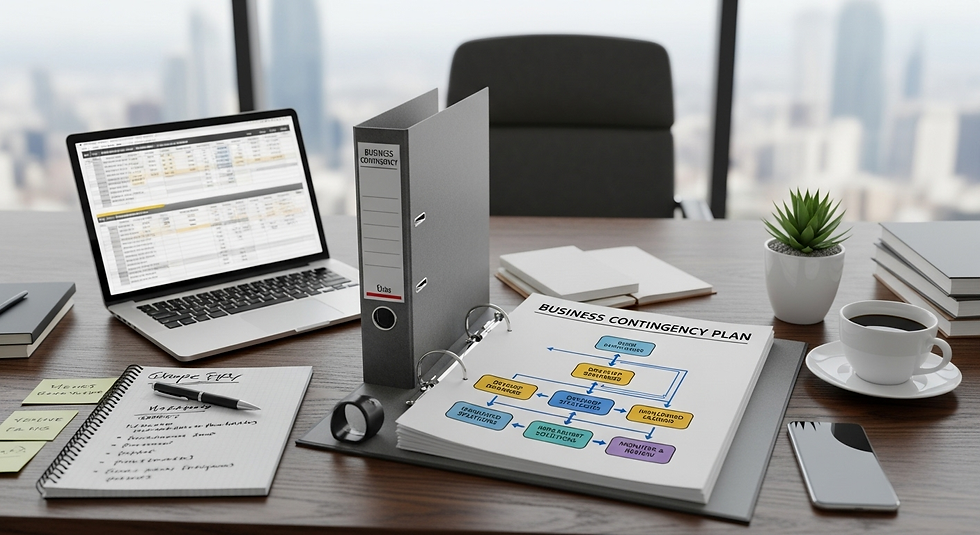How to Create a Resilient Organization: 7 Steps That Work
- rebekahh84
- May 30
- 4 min read

Organizations that succeed over time often rely on structured routines and tested processes. These systems usually function well when conditions are stable.
However, these routines can quickly fall apart during periods of uncertainty or crisis. Many businesses then struggle to respond effectively and make reactive changes with mixed results.
That is why leaders must shift their focus to thrive during turbulent times.
Building organizational resilience is not a single action or a checklist to complete. It is a journey that reshapes how teams
Think
Work
Adapt
Old habits may need to be replaced with new strategies. That process may feel challenging, but it also brings growth and opportunity.
This blog will guide you through the essential steps to build that resilience so your organization can not only survive but grow stronger in the face of uncertainty.
Why Manage Risk?

Every organization wants to reach its main goals. A business wants to earn profit and a nonprofit wants to provide a service. Different departments help protect the organization. Security handles threats and business continuity planning deals with interruptions. If these departments work alone, they may waste resources and repeat efforts. Their work must support the main goals of the organization or it has no value.
Risk and resilience management helps these departments work together. It creates one system that allows each team to follow the same plan and use resources wisely.
Managing risk helps leaders make better choices. It saves time and supports smart planning. It also helps the organization stay strong during hard times.
7 Steps to Building Organizational Resilience
Organizations must learn how to stay strong during quickly changing times. Companies that prepare before problems happen will recover faster and perform better. Here are the 7 steps that will create organizational resilience.
1. Start with People

People are the most essential part of every organization. The first step to building resilience is to support the employees. This means helping them feel safe and offering them tools to grow. Organizations should care about their well-being. They should also give them training and help them improve their skills.
Employees become stronger when they feel valued and supported. This makes the company stronger as well. Today many workers want their jobs to help them grow and feel part of something bigger. When leaders give their teams good support and real purpose, people stay committed.
What would happen if your operations stopped tomorrow? Find out how a business continuity consultant can help you stay prepared at the Business Contingency Group.
2.Create a Strong Workplace Culture

Culture is the way people work together in an organization. A strong culture helps people trust each other and work well as a team. Leaders should build a place where people can learn from mistakes and celebrate success together.
When everyone follows the same purpose and values, the whole team becomes more connected. This makes employees feel like they belong. When people feel connected to their workplace, they work harder and stay strong during hard times.
3.Lead with Honesty and Purpose

Resilient leaders always show what the organization stands for. They guide others by using clear values and real goals. Good leaders do more than just give orders. They build trust and help their team stay strong when things get hard.
A leader should always be there for their team. They must set goals that are clear and possible. They should also be open and listen to feedback. When a leader shows strength and care, the whole team feels safe and ready to face problems.
4.Use the Right Technology

Technology helps organizations become stronger and more prepared. However, it is not helpful to have too many tools that do not work well together. It is better to choose the right tools that help the team work better and solve problems faster.
Good technology should be easy to use. It should help with planning, communication, and recovery. When every part of the system works well together, it helps the organization stay ready for any situation. It should also be able to grow with the company as things change.
5. Stay Flexible and Be Ready to Adapt

A company must also be agile to be resilient. Agility means being able to change plans quickly when needed. It means making decisions fast and solving problems without delay.
Agile companies have systems that support quick changes. They do not wait for problems to grow before they act. Instead, they look for solutions early. This helps them stay ahead and deal with changes in the market.
6. Plan Before a Crisis Happens

Companies should not wait for problems to take action. and they must make plans before a crisis happens. These plans should help the team know what to do if something goes wrong. They should also be tested often to make sure they work.
When a company already has a plan, it can respond faster during an emergency. It also helps the company get back to normal more quickly and also saves time and money.
7. Keep Improving Through Smart Innovation

Some companies stop trying new things when times get hard but the strong companies do the opposite. They keep testing new ideas that do not cost too much and could help in the future.
They allow small projects that can lead to better results. These projects should be quick and based on real data. If something does not work, the team should learn from it and try again. This allows the company to keep moving forward even during tough times.
Final Thoughts
Building resilience takes time and effort. It is not a quick fix as it requires a new way of thinking and working.
You must support your team and must build a strong culture. You must make plans before things go wrong. If you do these things, your organization will not only survive during a crisis but will become stronger than before.
If you need help with building resilience or planning for the future, you can work with a professional who has experience with business continuity and risk management. Get expert guidance from a business continuity consultant who can strengthen your emergency response. Start your plan at the Business Contingency Group.




Comments